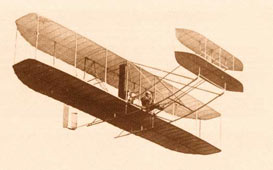|
On December 17, 1903, a wood and cloth biplane, representing four
years of intense research by Wilbur and Orville Wright, took off
from the dunes at Kitty Hawk, North Carolina, with Orville at the
controls—thereby making history's first controlled, sustained,
and powered flight. For the centennial of this great event, NOVA
presents a dramatic investigation of the Wrights' amazing
achievement.
To bring the Wrights' technological genius to life, this program
features authentic replicas of their brilliantly conceived craft, as
shown in thrilling test flights. The climax is the construction and
maiden flight of a replica Wright 1911 Model B, the pinnacle of the
brothers' accomplishments and the world's first practical
passenger-carrying flying machine, with all the essential technical
features of today's aircraft. Commissioned exclusively for the
program, the Model B is the handiwork of Ken Hyde, a retired airline
pilot and nationally recognized restorer of historic aircraft.
Also participating in the program are some of the world's foremost
Wright experts, including Tom Crouch, Senior Curator of the
Aeronautics Division at the National Air and Space Museum (NASM) and
author of
The Bishop's Boys: A Life of Wilbur and Orville Wright (see
our interview); and
John D. Anderson, Jr., Curator of Aerodynamics at NASM and author of
leading books on aeronautical engineering.
The NOVA team's stunning replicas of Wright machines recreate the
exact designs and materials used by the brothers—a
considerable challenge since the two were notoriously secretive and
destroyed most of their plans. Even so, Hyde and fellow Wright
enthusiast Rick Young were able to glean most of the brothers'
secrets from old photographs, family letters, purchase records, and
vintage aircraft in museums. For the Model B, Hyde was even given
access to an original Wright engine, which he then painstakingly
restored.
In recreating the Wrights' journey of discovery, Hyde and Young
start where the brothers did: with gliders for testing the
efficiency of wing shapes to produce lift, along with a three-axis
control system to keep the plane balanced in flight. One of the
brothers' key insights was to attack each of the three problems of
flight separately: lift, control, and propulsion. Only after they
had solved the first two with a series of increasingly more
sophisticated gliders did they set about creating a propulsion
system, using innovative wooden propellers and a lightweight,
home-built gasoline engine.
Even after their successful flight of December 17, 1903, the
brothers knew they had just begun, and devoted the rest of the
decade to honing and perfecting their invention to make it
practical. By 1910 they had the Model B, an airplane that was
modified to make the first air crossing of the continental U.S. in
1911. Wright-trained pilot Cal Rodgers was at the controls for that
flight, which took 49 days and was punctuated by numerous stops and
crash landings.
Since then, aviation has advanced by astonishing leaps and bounds.
It has been seven decades since a wood, wire, and cloth Wright
machine took to the skies with its distinctive warping wings and
dual-chain driven propellers—that is, until now. This program
shows that the Wright technology is still an impressive,
awe-inspiring sight.


|


|
The world's first airplane model, the Wright Flyer, in
flight

|
|
|

